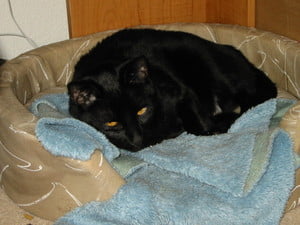Hyperthyroidism is the most common endocrine (or hormonal) disorder in cats. The thyroid hormone is important in regulating metabolism. The prefix ‘hyper-‘ means excessive. To begin with, it’s helpful to understand how a normal thyroid gland functions, then we can move on to what happens when it becomes overactive. Explanations will be given about how a cat is diagnosed, as well as details about the available treatment options.
What does the thyroid do?
The thyroid gland is located in the neck, and has two lobes. It is often described as being butterfly shaped. The thyroid gland absorbs iodine from the bloodstream to create tetraiodothyronine (T4 – also called thyroxine) and triiodothyronine (T3) by attaching four, and three iodine molecules to the amino acid tyrosine respectively. Cells in the body convert T4 to the ‘active’ form of T3 to be used in cell metabolism. The thyroid is so efficient at concentrating iodine that in humans, this small gland contains 25% of all iodine in the body. Cells use thyroid hormone in protein synthesis, and it also increases metabolic rate. As an example of how important the thyroid is to metabolism and development, a tadpole can be prevented from metamorphosing into a frog by blocking thyroxine, or the transformation started by adding it.
What happens in a hyperthyroid cat?
Hyperthyroidism, then, affects organs and systems in the whole body by increasing metabolism. This is why, not all hyperthyroid cats may display the same problems. Some symptoms are more common than others, but it is rare that any individual will exhibit all the signs presented here at once. Typical symptoms include: weight loss, increased appetite and water consumption, vomiting, diarrhea, dull fur or hair loss, and behavior changes, such as aggression, hyperactivity, or restlessness. To complicate things, around 10% of hyperthyroid cats show completely opposite signs, like poor appetite and weakness.
How will my veterinarian diagnose hyperthyroidism?
Usually this condition is seen in older cats, but can develop in kitties from 4 to 22 years old. Both males and females can be affected, as can any breed. On physical exam, the doctor may be able to feel an enlarged thyroid gland, but not always. Often they will notice an increased heart rate or a mummer. Approximately 87% of hyperthyroid cats have some degree of heart disease. To confirm the diagnosis, lab work should be run to look at the levels of T4 in the bloodstream. Normally elevated levels would be expected for a hyperthyroid cat, however it may be more difficult in some cases. If a cat is just starting to become hyperthyroid, or has a mild case in the beginning the T4 values may be in normal range. This is the case in up to 42% of cats. Often the doctor will run an additional test called a free T4 ED (this stands for equilibrium dialysis) that is a more sensitive measurement. Studies show that T4 values can fluctuate as much as 24% during a day. If hyperthyroidism is suspected, a single blood test may not rule it out.
Treatment Options:
Medication
Tapazole (or the generic Methimazole) is the most commonly prescribed anti-thyroid medication for cats. Medication has the advantages of being relatively inexpensive, and being reversible. The medication is available in tablets, or for owners who can’t give pills to their feline friends, a transdermal liquid is available that is placed on the cat’s earflaps.
Why may a reversible treatment be preferable?
Since hyperthyroidism is most commonly seen in older felines, they may also have other medical problems as well. Managing more than one medical condition can become much more complicated, and may require changes in treatment. A common example is a kitty that is hyperthyroid, and also has kidney disease. The increased metabolism associated with hyperthyroidism also increases the filtration rate by the kidneys. When a cat is treated for high thyroid, and kidney function returns to normal, it’s possible to find problems that were ‘hidden’ by the hyperthyroidism. Giving a reversible treatment, such as Tapazole, enables the doctor to monitor kidney function, and make adjustments to the treatment as needed. If the kidneys maintain good function while on medication, then an owner may consider a more permanent treatment option.
Possible side effects from the medication can be: vomiting, not eating, depression, and blood change and are usually only temporary as the cat adjusts to the drug. Using the transdermal version may take slightly longer to work, but by the time a cat has been on it for four weeks, both routes are equally effective. There tends to be fewer of the gastrointestinal side effects from using the transdermal application, but the earflaps can become crusty decreasing absorption. It is recommended that excess medication be cleaned off the ears an hour or so after treatment.
This could be considered a cure instead of a treatment, as 96 to 98% of treated cats regain normal thyroid function after the procedure. A subcutaneous injection of the radioactive isotope 131I is administered. This iodine is absorbed and concentrated in the thyroid gland as normal, and the radiation destroys the thyroid cells. The natural feedback system causes the normal thyroid cells to shut down when too much T4 is present, but the abnormal tumor cells don’t turn off. Since it is usually only the abnormal cells still functioning, this is how normal thyroid tissue is safe from the radiation, since it isn’t active and therefore won’t absorb the radioactive iodine. Once the abnormal tissue is killed, the normal thyroid will return to function. Very rarely a cat can have too much thyroid tissue destroyed, happening in only four out a thousand cases. 2% to 5% of feline radioiodine patients may need a second dose to destroy all abnormal thyroids. Sedation is seldom necessary.
After treatment cats will excrete radioactive isotopes for 4 to 10 days on average, and need to remain hospitalized during this time. Owners may be instructed on special handling of soiled litter for several more weeks at home.
Surgical Removal of the Thyroid Gland
The third possibility seems to be a less popular option. Removing the entire thyroid can lead to too little T4 later, requiring thyroid supplementation. There are also other important glands, such as the parathyroid, nestled in the same area, and can be accidentally damaged during surgery.
The pros and cons of the various treatment options should be weighed for each cat on an individual basis. Together, the doctor, and owner can formulate a plan that will best fill their needs.




